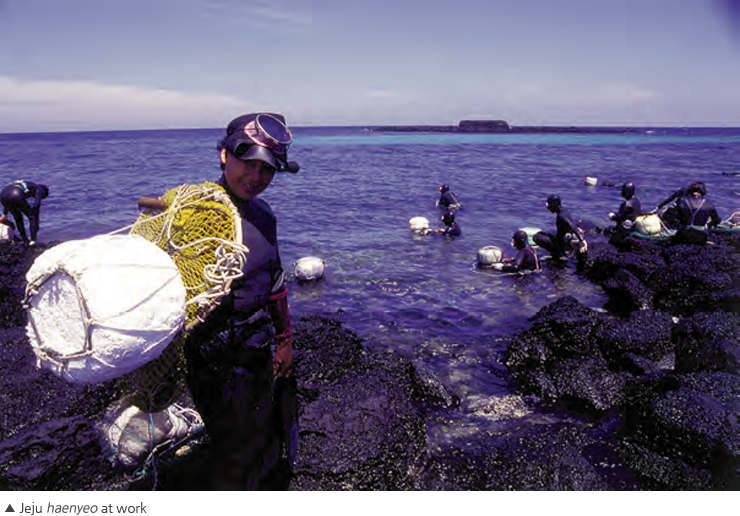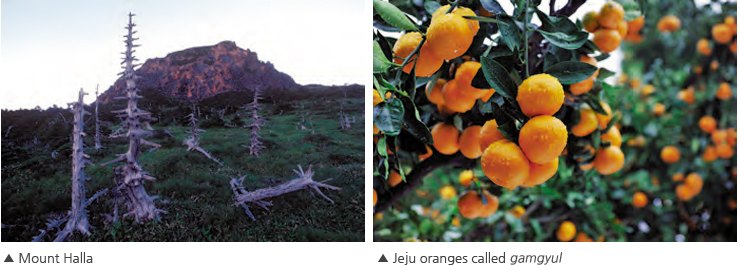Culture Focus
Local Culture: Jeju-do

Jeju-do is the largest island in South Korea. Historically, the island was called by many different names including Doi, Dongyeongju, Juho, Tammora, Seomna, and Tamna. According to Goryeosa (History of Goryeo), three brothers of the Go family who were the fifteenth descendants of Goeulla, one of the progenitors of the Jeju people, were received by the court of Silla at which time the name Tamna, meaning island, was officially recognized. The Go family was one of the three families that formed a tribal community in Jeju-do and eventually ruled the island after the Unified Silla period. It used to be under the jurisdiction of the Jeolla region until 1946 when it attained its longawaited independent provincial status as Jeju Special Autonomous Province. The island covers 1,846 square kilometers of area and consists of Jeju City, Seogwipo City, South Jeju County, and North Jeju County. In all, there are seven cities on Jeju-do. The year 2000 census shows that about five hundred and twenty thousand people live on the island. As a volcanic island, Jeju displays exotic natural beauty quite different from that of the mainland. Rising right in the center of the island is Hallasan or popularly called Mount Halla (1,950 meters), in the center of which is a crater. Volcanic activity continued even into the historic period producing lava tunnels and scoria mounds.
CC Waterfalls have developed where the lava used to flow into the sea displaying great spectacles and attracting hosts of tourists. The somewhat dark tones of the soil are characteristic of the region, which is covered mostly with basalt rock. The climate is benign and humid enough to develop dense temperate rainforests. A strong wind from the sea is another phenomenon of note on Jeju-do; it necessitates that the roofs of traditional houses be especially strong. In population structure, Jeju-do has maintained a sex ratio far below 100. In other words, the number of females had until very recently exceeded that of males. Another name for this place is samdado, which means three things are in abundance, namely, stones, wind, and women.
Jeju-do is composed of three areas; the coastal area (below 200 meters), the Piedmont area (200-500 meters), and the mountainous area (above 500 meters). The coastal area comprises about half of the entire region and it is in this area that most Jeju people live. The local population finds drinking water near the coast in the form of wells that gush out of the ground. The location of springs has been the single most important factor in the establishment of villages and towns. Traditional houses in each village reflect the distinct cultural character of the island. The southern influence is mirrored in the spacious wooden floor, and the northern influence is in the double-row structure.
Until very recently, the livelihood of Jeju people was based on dry farming and fishing. Rice paddies are so few here that their role in the regional economy is meager. The fishing industry features haenyeo or jamnyeo (female divers) and small to medium-sized fishing boats. From the mid-1960s on, orange cultivation and cattle farming in the Piedmont area have been common due to subsidies from local and central governments.
In a changed environment, tourism has become the leading sector. The exotic natural environment has helped to make the tourist industry prosper. In April 1977, the first car ferry from Busan to Jeju-do operated by Dongyanggosokhweri (Dongyang Express Ferry) was introduced. Soon other car ferries from Mokpo and Incheon began to operate increasing not only the number of visitors but also the convenience of bringing own vehicles on the trip. Additionally, domestic airlines connect with Seoul, Busan, Daegu, Gwangju, Yeosu, and Jinju on a regular basis. There are also several international airlines that transport foreign tourists to the region.
CC Waterfalls have developed where the lava used to flow into the sea displaying great spectacles and attracting hosts of tourists. The somewhat dark tones of the soil are characteristic of the region, which is covered mostly with basalt rock. The climate is benign and humid enough to develop dense temperate rainforests. A strong wind from the sea is another phenomenon of note on Jeju-do; it necessitates that the roofs of traditional houses be especially strong. In population structure, Jeju-do has maintained a sex ratio far below 100. In other words, the number of females had until very recently exceeded that of males. Another name for this place is samdado, which means three things are in abundance, namely, stones, wind, and women.
Jeju-do is composed of three areas; the coastal area (below 200 meters), the Piedmont area (200-500 meters), and the mountainous area (above 500 meters). The coastal area comprises about half of the entire region and it is in this area that most Jeju people live. The local population finds drinking water near the coast in the form of wells that gush out of the ground. The location of springs has been the single most important factor in the establishment of villages and towns. Traditional houses in each village reflect the distinct cultural character of the island. The southern influence is mirrored in the spacious wooden floor, and the northern influence is in the double-row structure.
Until very recently, the livelihood of Jeju people was based on dry farming and fishing. Rice paddies are so few here that their role in the regional economy is meager. The fishing industry features haenyeo or jamnyeo (female divers) and small to medium-sized fishing boats. From the mid-1960s on, orange cultivation and cattle farming in the Piedmont area have been common due to subsidies from local and central governments.
In a changed environment, tourism has become the leading sector. The exotic natural environment has helped to make the tourist industry prosper. In April 1977, the first car ferry from Busan to Jeju-do operated by Dongyanggosokhweri (Dongyang Express Ferry) was introduced. Soon other car ferries from Mokpo and Incheon began to operate increasing not only the number of visitors but also the convenience of bringing own vehicles on the trip. Additionally, domestic airlines connect with Seoul, Busan, Daegu, Gwangju, Yeosu, and Jinju on a regular basis. There are also several international airlines that transport foreign tourists to the region.

In the 1980s with the creation of Jungmun Resort (Jungmun Tourist Complex) Jeju-do became Korea’s favorite honeymoon destination. It is estimated that after 2005 more than five million tourists visit Jeju-do each year. In 2010 the number of visitors to Jeju-do reached five million just in the first half of the year raising expectations that the goal of reaching 10 million is just around the corner.
The visitors are usually newly married couples, international tourists, and sightseers. Local cultural treasures resulting from its geographical isolation provide tourists with diverse aspects of the island to enjoy. They go to see and appreciate the beauty of traditional folk villages, dragon rock, female divers, orange orchards, canola fields, native ponies, various historic sites, lava tunnels, local delicacies, the sacred cave of three saints, nutmeg forestry, the sun rising over a scoria mound, and scattered pastoral fishing villages. Accordingly, the service industry prospers throughout all seasons of the year.
The visitors are usually newly married couples, international tourists, and sightseers. Local cultural treasures resulting from its geographical isolation provide tourists with diverse aspects of the island to enjoy. They go to see and appreciate the beauty of traditional folk villages, dragon rock, female divers, orange orchards, canola fields, native ponies, various historic sites, lava tunnels, local delicacies, the sacred cave of three saints, nutmeg forestry, the sun rising over a scoria mound, and scattered pastoral fishing villages. Accordingly, the service industry prospers throughout all seasons of the year.
Cultural Landscapes of Korea
This book deals with a wide variety of subjects on Korean culture ranging from the country’s traditional lifestyle to the cultural changes that the country is going through in the midst of industrialization and globalization [including increase in the number of international marriages, which leads to multicultural families, hallyu (Korean wave, supranational food and fashion, etc.]. The rich content of the book, along with the relevant photos, will help readers understand the culture and history of Korea better.
This book deals with a wide variety of subjects on Korean culture ranging from the country’s traditional lifestyle to the cultural changes that the country is going through in the midst of industrialization and globalization [including increase in the number of international marriages, which leads to multicultural families, hallyu (Korean wave, supranational food and fashion, etc.]. The rich content of the book, along with the relevant photos, will help readers understand the culture and history of Korea better.

